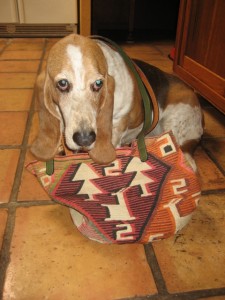Stellar Shigras
Andean textiles have the longest historical record in the world, with scholarly estimates dating them back to 3000 B.C.
![ecu8057[1]](https://blog.itscactus.com/wp-content/uploads/2012/07/ecu805711-196x300.jpg)
This shigra is particularly valuable, both because of its size and because of the pictoral as well as geometric aspects of its design.
Despite their emergence on the contemporary style scene, the method of producing shigras has changed little since ancient Incan days. Leaves from the succulent plant known variously as cabuya, penca, fique, or maguey (similar to agave) are harvested and cut into slender strips. Next, they are soaked for a period of 15 days to separate the pulp from the fibers. Once they are separated and dried, the fibers are cut int
o fine strands and dyed. Originally, vegetal dyes were used, but as they are not colorfast, aniline dyes have largely replaced them. The colored fibers are then wound onto spindles and from there, the weaving begins.
Starting at the base, the weaver – who is almost always female – uses a blunt needle and begins a looping sequence rather like crocheting. Round and round she goes in an ever-widening circle, eventually forming the seamless bag. She will create wonderful patterns of color as she works her way through the piece. Prior to 1970, human and animal forms were very typical, though those are rarely seen now, having
given way to a trend of geometric shapes. The finished bag will have two long, braided, cross-body fiber straps.
 That’s how mine looked, the day it was given to me. A beautiful shigra with bold geometric patterns, animals, trees, numbers, and letters in pink, red,orange, brown and black and two long fiber straps. Two days later, however, it had been altered by my dog, who decided to add a little fiber to her diet, I guess. She had a mouthful and my straps were a tattered mess. I said, “Oh no, no, no, you naughty Little Darling,” or maybe something a tiny bit stronger, and saved what I could. I retied the ends and that worked well enough for a while, but admittedly, they were a little short. Eventually I replaced them entirely with leather. This was at no small expense, but in all honesty, I think it was worth the price. The new handles nicely preserve the integrity of my shigra and I happily carry a fantastically functional and fashionable Andean textile everywhere I go. My basset hound too, is pleased with my shigra’s stylish utility and she is very glad she didn’t eat the whole thing after all.
That’s how mine looked, the day it was given to me. A beautiful shigra with bold geometric patterns, animals, trees, numbers, and letters in pink, red,orange, brown and black and two long fiber straps. Two days later, however, it had been altered by my dog, who decided to add a little fiber to her diet, I guess. She had a mouthful and my straps were a tattered mess. I said, “Oh no, no, no, you naughty Little Darling,” or maybe something a tiny bit stronger, and saved what I could. I retied the ends and that worked well enough for a while, but admittedly, they were a little short. Eventually I replaced them entirely with leather. This was at no small expense, but in all honesty, I think it was worth the price. The new handles nicely preserve the integrity of my shigra and I happily carry a fantastically functional and fashionable Andean textile everywhere I go. My basset hound too, is pleased with my shigra’s stylish utility and she is very glad she didn’t eat the whole thing after all.
